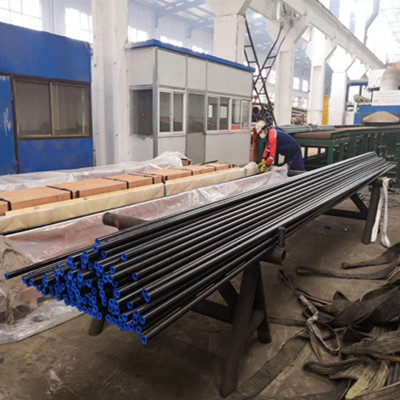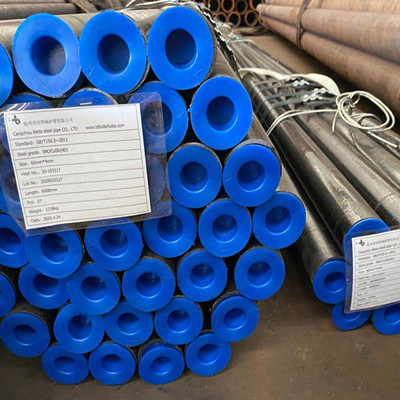Metallic material
Metallic material
There are many types of metal materials. Metals are usually divided into two categories: ferrous metals and non-ferrous metals. Ferrous metals include iron, manganese, chromium, and their alloys. Other metals are called non-ferrous metals. ''
Ferrous metals
(1) Pig iron
Pig iron refers to iron-carbon alloys with a carbon content greater than 2%. Industrial pig iron generally contains no more than 4.5% carbon. According to its composition, performance and use, pig iron is divided into steel-making pig iron, cast iron (gray iron), and alloy pig iron.
(2) Ferroalloy
Iron alloy is an alloy of iron and a certain amount of other metal elements. Ferroalloy is one of the raw materials for steel making. It is used as steel deoxidizer and alloy element additive during steelmaking to improve steel performance.
(3) Carbon steel
Carbon steel, also called carbon steel, is an iron-carbon alloy containing less than 2% carbon. Carbon steel generally contains a small amount of silicon, manganese, sulfur, and phosphorus in addition to carbon.
(4) Carbon structural steel
Carbon structural steel is also called high-quality carbon structural steel, and its carbon content is less than 0.8%. Except for a few, the carbon content is very low
The steel grade can be smelted except boiling steel, the rest are smelted killed steel.
(5) Carbon tool steel
Carbon tool steel is a high-carbon steel that basically contains no alloy elements. The carbon content is in the range of 0.65% to 1.35%. The production cost of carbon tool steel is low, the source of raw materials is easy to obtain, and the processability is good. It has high hardness and high wear resistance, so it is a widely used steel type for manufacturing various cutting tools, molds, and measuring tools. However, this type of steel has poor red hardness, that is, when the working temperature is greater than 250°C, the hardness and wear resistance of the steel will drop sharply and lose its ability to work. In addition, if carbon tool steel is made into larger parts, it is not easy to harden, and it is easy to deform and crack.
(6) Alloy steel
In addition to iron, carbon and a small amount of inevitable elements of silicon, manganese, phosphorus, and sulfur, alloy steel also contains a certain amount of alloy elements. The alloy elements in steel include silicon, manganese, molybdenum, nickel, chromium, and vanadium. , Titanium, niobium, boron, aluminum, rare earth, etc. one or more of them.
The alloy steel systems of various countries vary with their respective resource conditions, production and use conditions. Foreign countries have developed nickel and chromium steel systems in the past, while China has developed silicon, manganese, alum, titanium, niobium, boron, and rare earths. Alloy steel system.
(7) Stainless steel
Stainless steel is a special steel. According to the microstructure after heat treatment, it can be divided into 5 categories: ferritic stainless steel, martensitic stainless steel, austenitic stainless steel, duplex stainless steel, and precipitation hardening stainless steel.
(8) High temperature alloy
High temperature alloy refers to a heat-strength material with sufficient endurance strength, creep strength, and thermal fatigue strength at high temperature: high temperature toughness and sufficient chemical stability. It is used for heat working under high temperature conditions around 1000℃ Power parts.
(9) Steel plate
Steel plates are divided into thin plates (less than 4mm, including steel strip) and thick plates (4~60mm, including extra thick plates above 60mm) according to thickness.
(10) Steel pipe
Steel pipes are divided into two categories according to the presence or absence of joints, namely welded steel pipes (seamed steel pipes) and seamless steel pipes.
(11) Shape steel
Shaped steel is one of the four major varieties of steel (plate, tube, shape, wire). According to the shape of the section, the section steel is divided into simple section steel and complex section steel (shaped steel). The former refers to square steel, round steel, flat steel, angle steel, hexagonal steel, etc., the latter refers to I-beam, channel steel, rails, window frame steel, bent steel, etc.
(11) Wire
Steel wire usually refers to a product that is made of hot-rolled wire (wire rod) as a raw material and undergoes cold drawing
Non-ferrous metals
(1) Light non-ferrous metals
Light non-ferrous metals generally refer to non-ferrous metals with relative density below 4.5, including aluminum, magnesium, sodium,
Potassium, calcium, strontium, barium. The common characteristics of these metals are: relative density is small (0.53~4.5), chemical activity is large, and compounds with oxygen, sulfur, carbon and halogen are quite stable.
(2) Heavy non-ferrous metals
Heavy non-ferrous metals generally refer to non-ferrous metals with relative density above 4.5, including copper, nickel,
Lead, zinc, cobalt, tin, antimony, mercury, cadmium, bismuth.
(3) The precious metals include gold, silver and platinum group elements (platinum, iridium, osmium, ruthenium, palladium, rhodium). Because of their stability to oxygen and other reagents, and their low content in the earth's crust, mining and extraction are more difficult, so the price is more expensive than ordinary metals, so they are named precious metals.
(4) Rare earth metals
Rare earth metals include lanthanides and scandium and yttrium, which are similar in properties to lanthanides. There are 17 types in total:
Scandium (Sc), yttrium (Y), lanthanum (La), cerium (Ce), praseodymium (Pr), neodymium (Nd), promethium (CPm), samarium (Sm), europium (Eu), gadolinium (Gd), terbium (Tb), Dysprosium (Dy), Holmium (H.), Erbium (Er), Thulium (Tm), Ytterbium (Yb) and Lutetium (Lu). From lanthanum to europium is also called light rare earth, from gadolinium to lutetium including scandium and yttrium is called heavy rare earth. .
There are many types of metal materials. Metals are usually divided into two categories: ferrous metals and non-ferrous metals. Ferrous metals include iron, manganese, chromium, and their alloys. Other metals are called non-ferrous metals. ''
Ferrous metals
(1) Pig iron
Pig iron refers to iron-carbon alloys with a carbon content greater than 2%. Industrial pig iron generally contains no more than 4.5% carbon. According to its composition, performance and use, pig iron is divided into steel-making pig iron, cast iron (gray iron), and alloy pig iron.
(2) Ferroalloy
Iron alloy is an alloy of iron and a certain amount of other metal elements. Ferroalloy is one of the raw materials for steel making. It is used as steel deoxidizer and alloy element additive during steelmaking to improve steel performance.
(3) Carbon steel
Carbon steel, also called carbon steel, is an iron-carbon alloy containing less than 2% carbon. Carbon steel generally contains a small amount of silicon, manganese, sulfur, and phosphorus in addition to carbon.
(4) Carbon structural steel
Carbon structural steel is also called high-quality carbon structural steel, and its carbon content is less than 0.8%. Except for a few, the carbon content is very low
The steel grade can be smelted except boiling steel, the rest are smelted killed steel.
(5) Carbon tool steel
Carbon tool steel is a high-carbon steel that basically contains no alloy elements. The carbon content is in the range of 0.65% to 1.35%. The production cost of carbon tool steel is low, the source of raw materials is easy to obtain, and the processability is good. It has high hardness and high wear resistance, so it is a widely used steel type for manufacturing various cutting tools, molds, and measuring tools. However, this type of steel has poor red hardness, that is, when the working temperature is greater than 250°C, the hardness and wear resistance of the steel will drop sharply and lose its ability to work. In addition, if carbon tool steel is made into larger parts, it is not easy to harden, and it is easy to deform and crack.
(6) Alloy steel
In addition to iron, carbon and a small amount of inevitable elements of silicon, manganese, phosphorus, and sulfur, alloy steel also contains a certain amount of alloy elements. The alloy elements in steel include silicon, manganese, molybdenum, nickel, chromium, and vanadium. , Titanium, niobium, boron, aluminum, rare earth, etc. one or more of them.
The alloy steel systems of various countries vary with their respective resource conditions, production and use conditions. Foreign countries have developed nickel and chromium steel systems in the past, while China has developed silicon, manganese, alum, titanium, niobium, boron, and rare earths. Alloy steel system.
(7) Stainless steel
Stainless steel is a special steel. According to the microstructure after heat treatment, it can be divided into 5 categories: ferritic stainless steel, martensitic stainless steel, austenitic stainless steel, duplex stainless steel, and precipitation hardening stainless steel.
(8) High temperature alloy
High temperature alloy refers to a heat-strength material with sufficient endurance strength, creep strength, and thermal fatigue strength at high temperature: high temperature toughness and sufficient chemical stability. It is used for heat working under high temperature conditions around 1000℃ Power parts.
(9) Steel plate
Steel plates are divided into thin plates (less than 4mm, including steel strip) and thick plates (4~60mm, including extra thick plates above 60mm) according to thickness.
(10) Steel pipe
Steel pipes are divided into two categories according to the presence or absence of joints, namely welded steel pipes (seamed steel pipes) and seamless steel pipes.
(11) Shape steel
Shaped steel is one of the four major varieties of steel (plate, tube, shape, wire). According to the shape of the section, the section steel is divided into simple section steel and complex section steel (shaped steel). The former refers to square steel, round steel, flat steel, angle steel, hexagonal steel, etc., the latter refers to I-beam, channel steel, rails, window frame steel, bent steel, etc.
(11) Wire
Steel wire usually refers to a product that is made of hot-rolled wire (wire rod) as a raw material and undergoes cold drawing
Non-ferrous metals
(1) Light non-ferrous metals
Light non-ferrous metals generally refer to non-ferrous metals with relative density below 4.5, including aluminum, magnesium, sodium,
Potassium, calcium, strontium, barium. The common characteristics of these metals are: relative density is small (0.53~4.5), chemical activity is large, and compounds with oxygen, sulfur, carbon and halogen are quite stable.
(2) Heavy non-ferrous metals
Heavy non-ferrous metals generally refer to non-ferrous metals with relative density above 4.5, including copper, nickel,
Lead, zinc, cobalt, tin, antimony, mercury, cadmium, bismuth.
(3) The precious metals include gold, silver and platinum group elements (platinum, iridium, osmium, ruthenium, palladium, rhodium). Because of their stability to oxygen and other reagents, and their low content in the earth's crust, mining and extraction are more difficult, so the price is more expensive than ordinary metals, so they are named precious metals.
(4) Rare earth metals
Rare earth metals include lanthanides and scandium and yttrium, which are similar in properties to lanthanides. There are 17 types in total:
Scandium (Sc), yttrium (Y), lanthanum (La), cerium (Ce), praseodymium (Pr), neodymium (Nd), promethium (CPm), samarium (Sm), europium (Eu), gadolinium (Gd), terbium (Tb), Dysprosium (Dy), Holmium (H.), Erbium (Er), Thulium (Tm), Ytterbium (Yb) and Lutetium (Lu). From lanthanum to europium is also called light rare earth, from gadolinium to lutetium including scandium and yttrium is called heavy rare earth. .




